Economics Assignment: Market Structures, Competition, and Oligopolies
VerifiedAdded on 2022/11/18
|8
|1536
|170
Homework Assignment
AI Summary
This economics assignment delves into various market structures, including perfect competition, monopoly, monopolistic competition, and oligopoly, providing detailed comparisons of their characteristics. It analyzes real-world examples like Aldi supermarkets, Crown Casino, and the Commonwealth Bank to illustrate these structures. The assignment further explores non-price competition strategies used by firms, such as customer focus, service enhancements, and extensive distribution, particularly within monopolistic and oligopolistic markets. It also explains the concept of mutual dependence in oligopolies, where firms' decisions are influenced by their competitors' actions. Finally, the assignment examines the kinked demand curve, a characteristic of oligopolistic markets, using the example of the mobile phone industry, specifically focusing on the competition between Samsung and Apple.
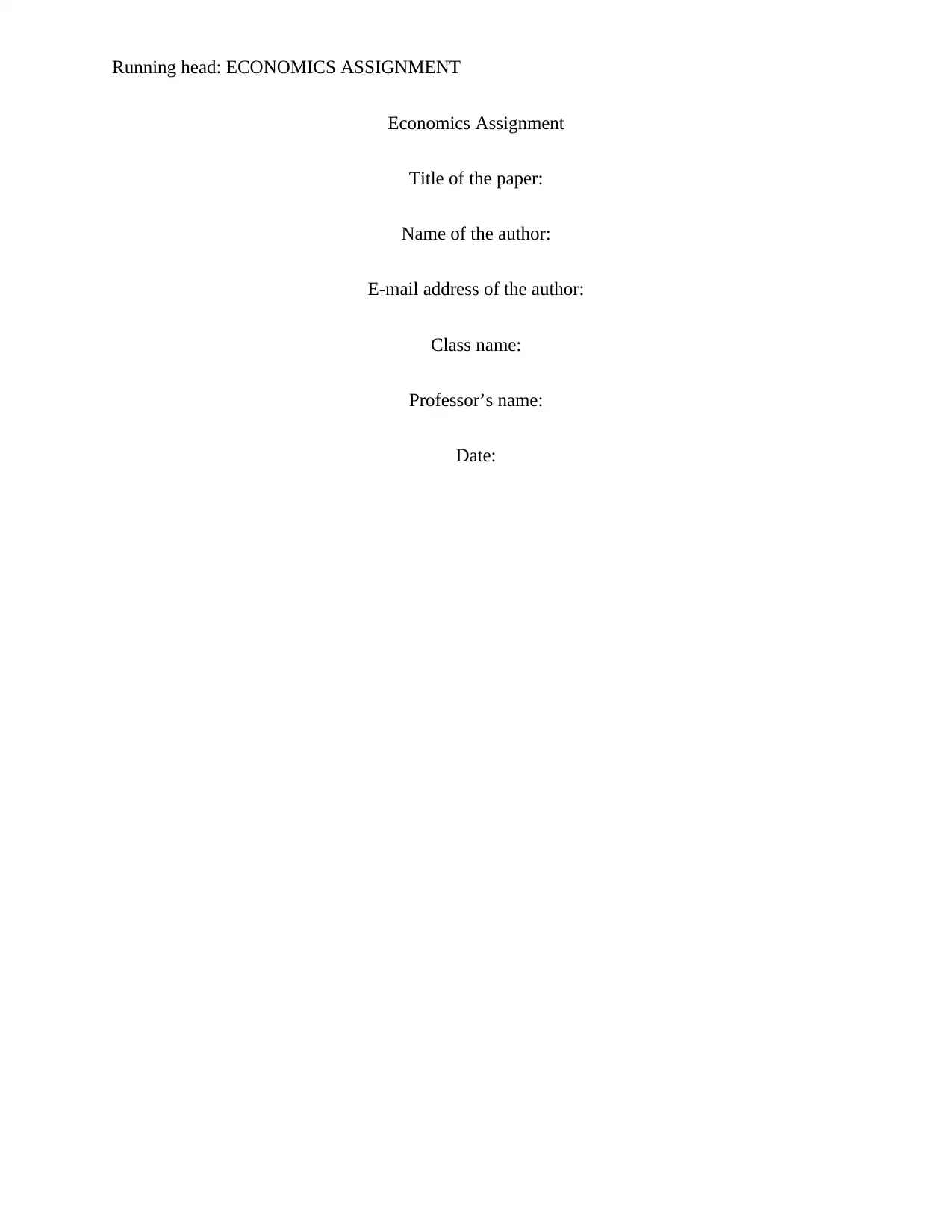
Running head: ECONOMICS ASSIGNMENT
Economics Assignment
Title of the paper:
Name of the author:
E-mail address of the author:
Class name:
Professor’s name:
Date:
Economics Assignment
Title of the paper:
Name of the author:
E-mail address of the author:
Class name:
Professor’s name:
Date:
Paraphrase This Document
Need a fresh take? Get an instant paraphrase of this document with our AI Paraphraser
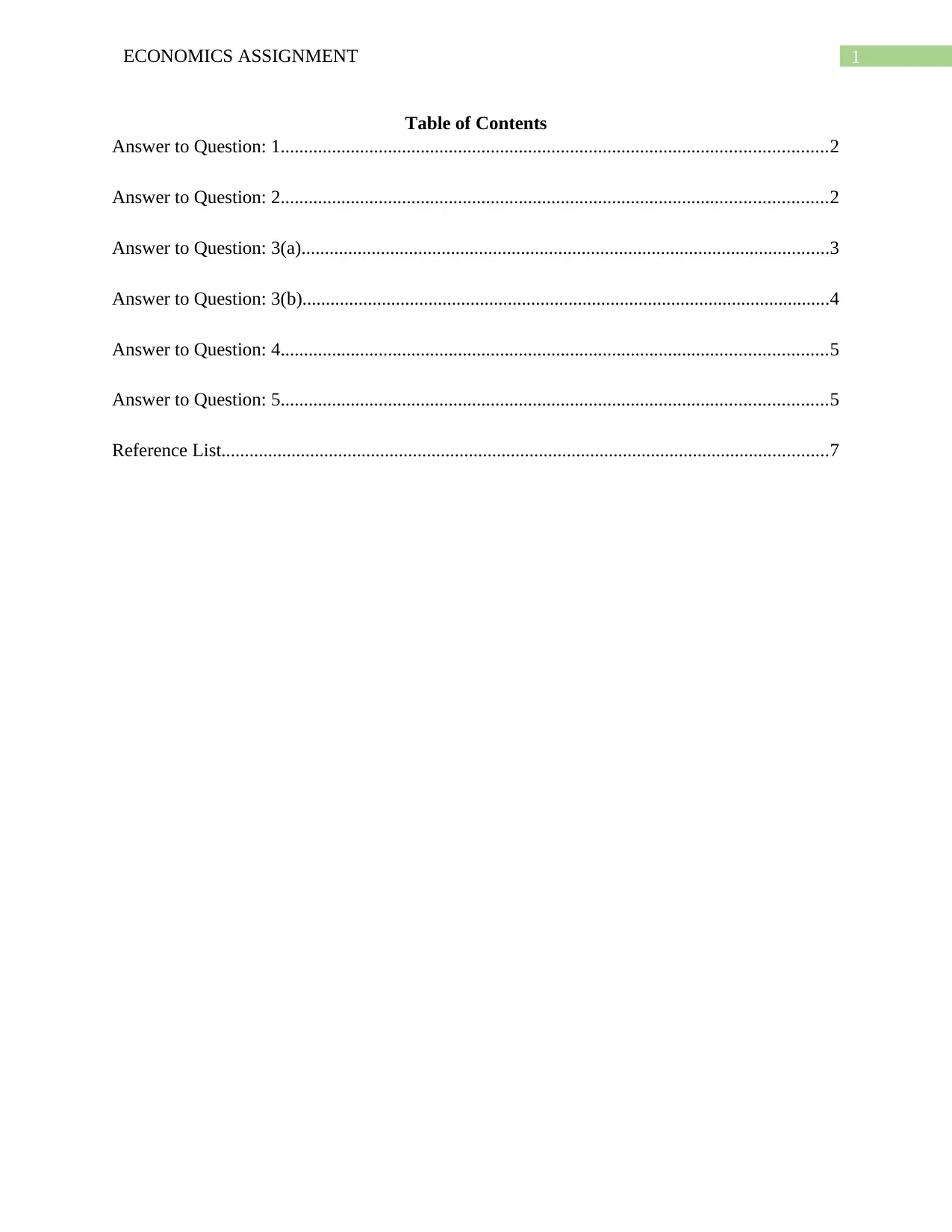
1ECONOMICS ASSIGNMENT
Table of Contents
Answer to Question: 1.....................................................................................................................2
Answer to Question: 2.....................................................................................................................2
Answer to Question: 3(a).................................................................................................................3
Answer to Question: 3(b).................................................................................................................4
Answer to Question: 4.....................................................................................................................5
Answer to Question: 5.....................................................................................................................5
Reference List..................................................................................................................................7
Table of Contents
Answer to Question: 1.....................................................................................................................2
Answer to Question: 2.....................................................................................................................2
Answer to Question: 3(a).................................................................................................................3
Answer to Question: 3(b).................................................................................................................4
Answer to Question: 4.....................................................................................................................5
Answer to Question: 5.....................................................................................................................5
Reference List..................................................................................................................................7
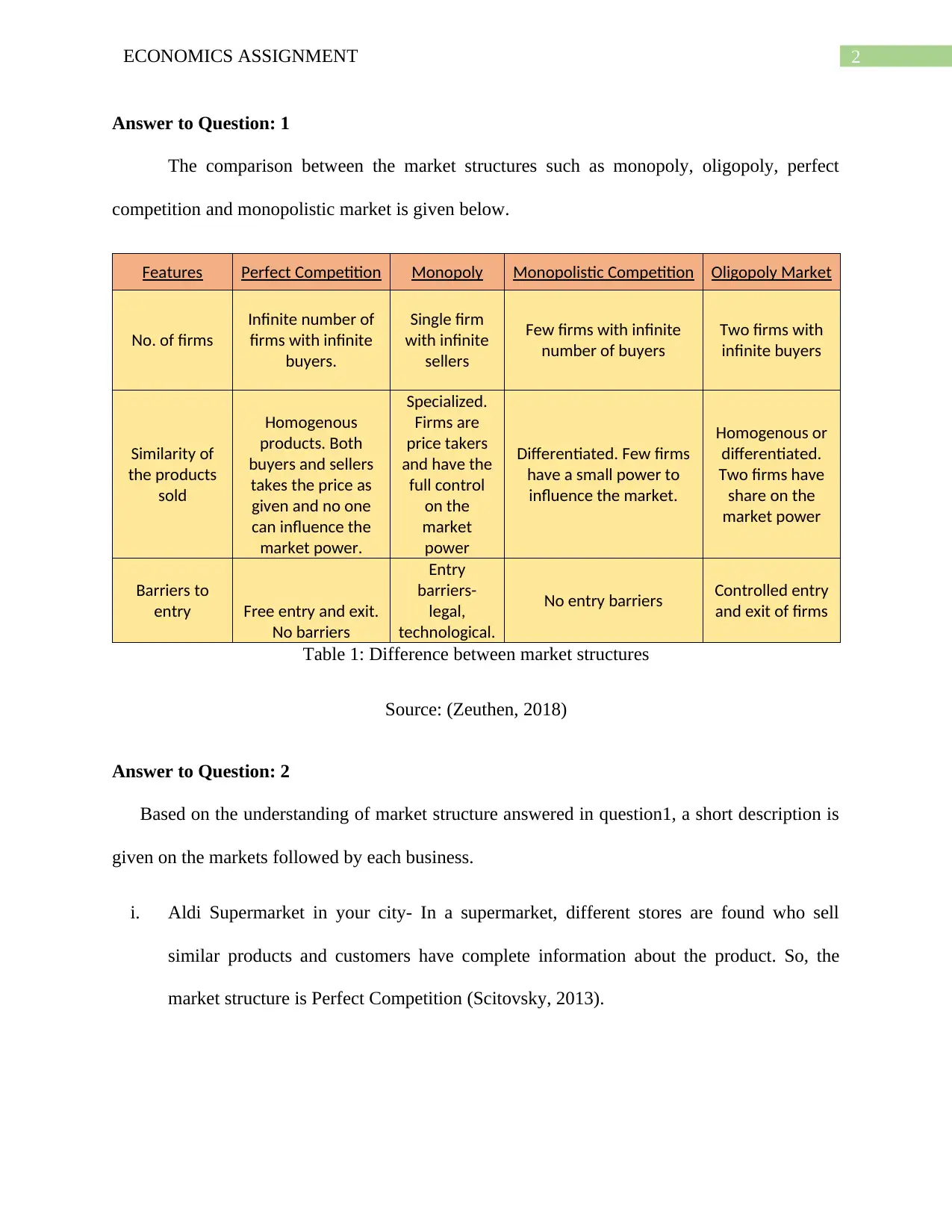
2ECONOMICS ASSIGNMENT
Answer to Question: 1
The comparison between the market structures such as monopoly, oligopoly, perfect
competition and monopolistic market is given below.
Features Perfect Competition Monopoly Monopolistic Competition Oligopoly Market
No. of firms
Infinite number of
firms with infinite
buyers.
Single firm
with infinite
sellers
Few firms with infinite
number of buyers
Two firms with
infinite buyers
Similarity of
the products
sold
Homogenous
products. Both
buyers and sellers
takes the price as
given and no one
can influence the
market power.
Specialized.
Firms are
price takers
and have the
full control
on the
market
power
Differentiated. Few firms
have a small power to
influence the market.
Homogenous or
differentiated.
Two firms have
share on the
market power
Barriers to
entry Free entry and exit.
No barriers
Entry
barriers-
legal,
technological.
No entry barriers Controlled entry
and exit of firms
Table 1: Difference between market structures
Source: (Zeuthen, 2018)
Answer to Question: 2
Based on the understanding of market structure answered in question1, a short description is
given on the markets followed by each business.
i. Aldi Supermarket in your city- In a supermarket, different stores are found who sell
similar products and customers have complete information about the product. So, the
market structure is Perfect Competition (Scitovsky, 2013).
Answer to Question: 1
The comparison between the market structures such as monopoly, oligopoly, perfect
competition and monopolistic market is given below.
Features Perfect Competition Monopoly Monopolistic Competition Oligopoly Market
No. of firms
Infinite number of
firms with infinite
buyers.
Single firm
with infinite
sellers
Few firms with infinite
number of buyers
Two firms with
infinite buyers
Similarity of
the products
sold
Homogenous
products. Both
buyers and sellers
takes the price as
given and no one
can influence the
market power.
Specialized.
Firms are
price takers
and have the
full control
on the
market
power
Differentiated. Few firms
have a small power to
influence the market.
Homogenous or
differentiated.
Two firms have
share on the
market power
Barriers to
entry Free entry and exit.
No barriers
Entry
barriers-
legal,
technological.
No entry barriers Controlled entry
and exit of firms
Table 1: Difference between market structures
Source: (Zeuthen, 2018)
Answer to Question: 2
Based on the understanding of market structure answered in question1, a short description is
given on the markets followed by each business.
i. Aldi Supermarket in your city- In a supermarket, different stores are found who sell
similar products and customers have complete information about the product. So, the
market structure is Perfect Competition (Scitovsky, 2013).
⊘ This is a preview!⊘
Do you want full access?
Subscribe today to unlock all pages.

Trusted by 1+ million students worldwide
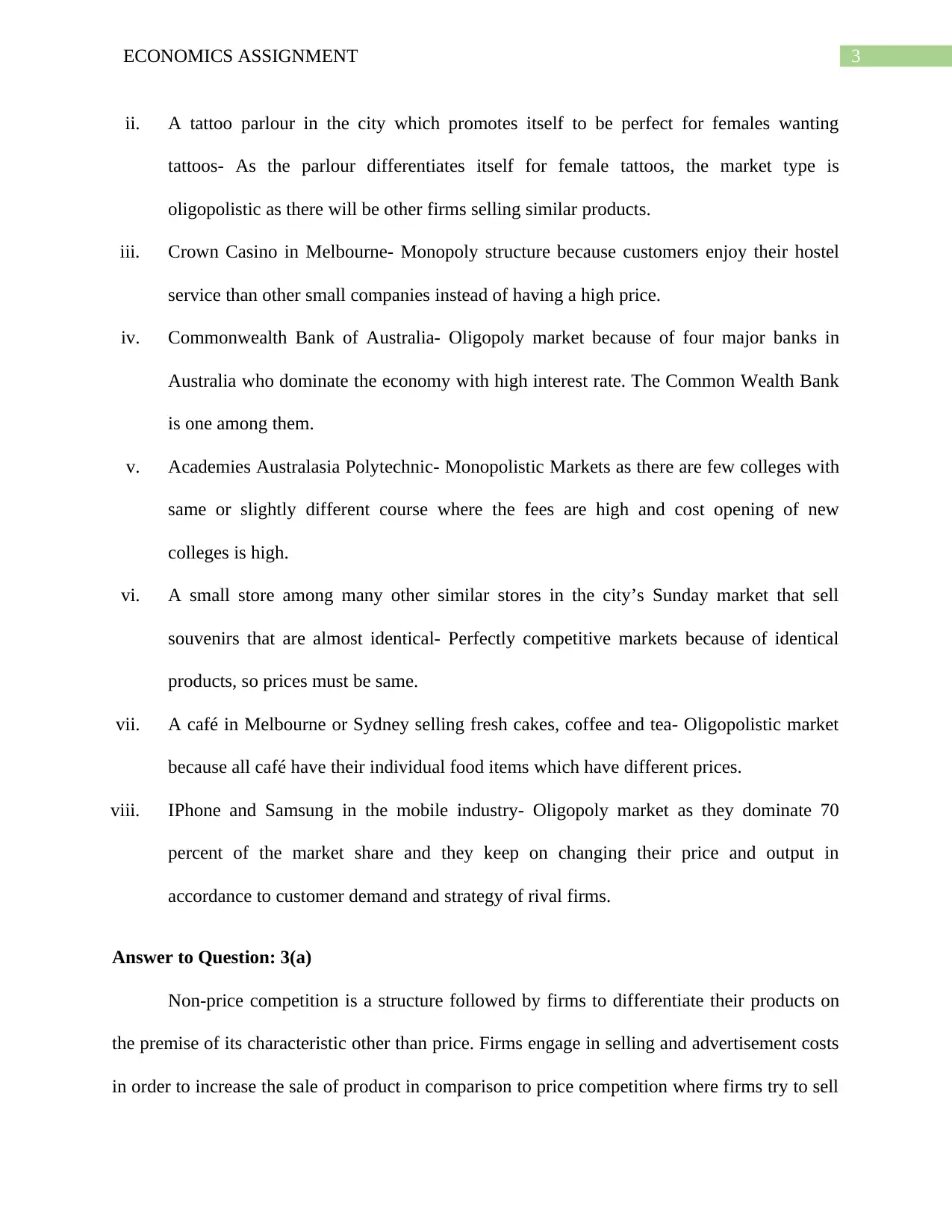
3ECONOMICS ASSIGNMENT
ii. A tattoo parlour in the city which promotes itself to be perfect for females wanting
tattoos- As the parlour differentiates itself for female tattoos, the market type is
oligopolistic as there will be other firms selling similar products.
iii. Crown Casino in Melbourne- Monopoly structure because customers enjoy their hostel
service than other small companies instead of having a high price.
iv. Commonwealth Bank of Australia- Oligopoly market because of four major banks in
Australia who dominate the economy with high interest rate. The Common Wealth Bank
is one among them.
v. Academies Australasia Polytechnic- Monopolistic Markets as there are few colleges with
same or slightly different course where the fees are high and cost opening of new
colleges is high.
vi. A small store among many other similar stores in the city’s Sunday market that sell
souvenirs that are almost identical- Perfectly competitive markets because of identical
products, so prices must be same.
vii. A café in Melbourne or Sydney selling fresh cakes, coffee and tea- Oligopolistic market
because all café have their individual food items which have different prices.
viii. IPhone and Samsung in the mobile industry- Oligopoly market as they dominate 70
percent of the market share and they keep on changing their price and output in
accordance to customer demand and strategy of rival firms.
Answer to Question: 3(a)
Non-price competition is a structure followed by firms to differentiate their products on
the premise of its characteristic other than price. Firms engage in selling and advertisement costs
in order to increase the sale of product in comparison to price competition where firms try to sell
ii. A tattoo parlour in the city which promotes itself to be perfect for females wanting
tattoos- As the parlour differentiates itself for female tattoos, the market type is
oligopolistic as there will be other firms selling similar products.
iii. Crown Casino in Melbourne- Monopoly structure because customers enjoy their hostel
service than other small companies instead of having a high price.
iv. Commonwealth Bank of Australia- Oligopoly market because of four major banks in
Australia who dominate the economy with high interest rate. The Common Wealth Bank
is one among them.
v. Academies Australasia Polytechnic- Monopolistic Markets as there are few colleges with
same or slightly different course where the fees are high and cost opening of new
colleges is high.
vi. A small store among many other similar stores in the city’s Sunday market that sell
souvenirs that are almost identical- Perfectly competitive markets because of identical
products, so prices must be same.
vii. A café in Melbourne or Sydney selling fresh cakes, coffee and tea- Oligopolistic market
because all café have their individual food items which have different prices.
viii. IPhone and Samsung in the mobile industry- Oligopoly market as they dominate 70
percent of the market share and they keep on changing their price and output in
accordance to customer demand and strategy of rival firms.
Answer to Question: 3(a)
Non-price competition is a structure followed by firms to differentiate their products on
the premise of its characteristic other than price. Firms engage in selling and advertisement costs
in order to increase the sale of product in comparison to price competition where firms try to sell
Paraphrase This Document
Need a fresh take? Get an instant paraphrase of this document with our AI Paraphraser
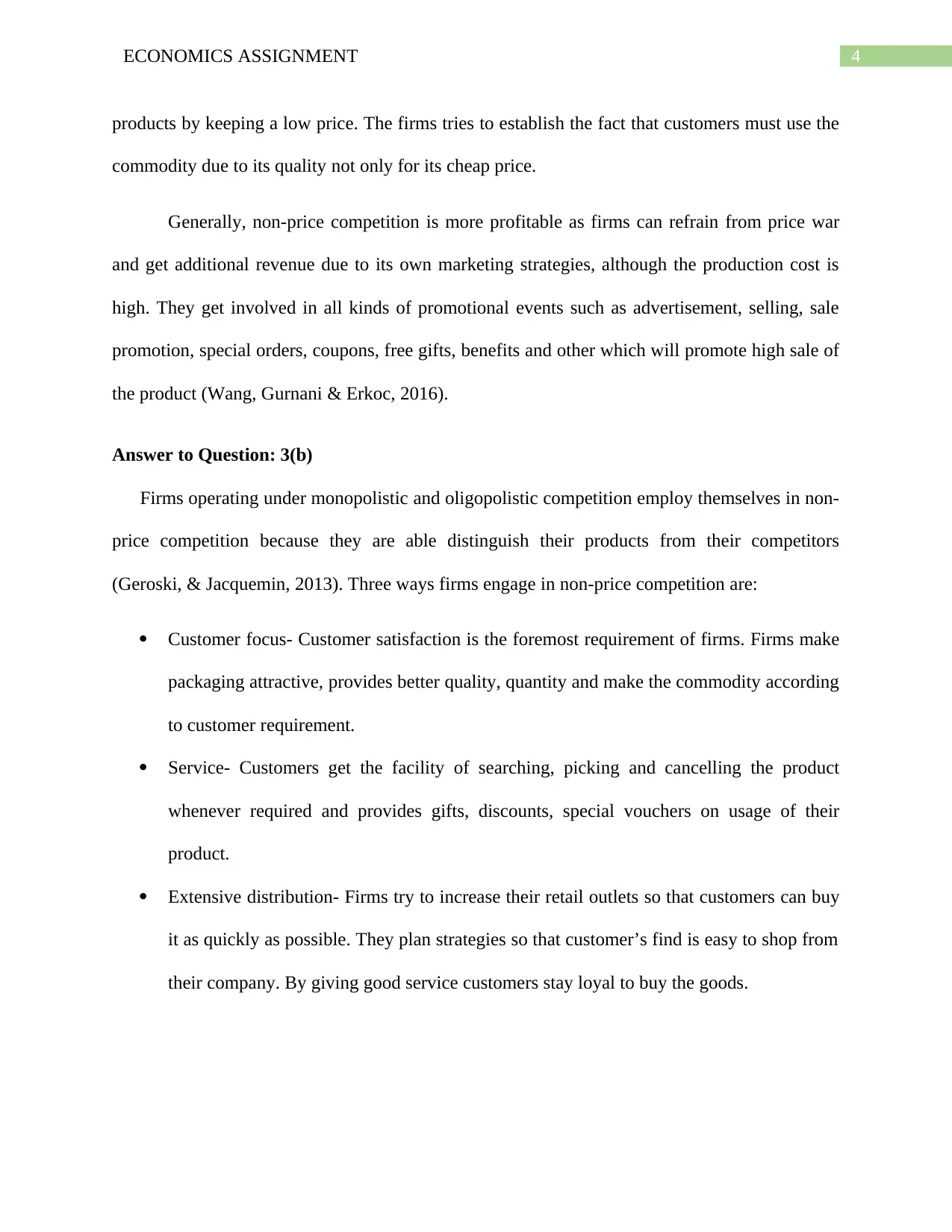
4ECONOMICS ASSIGNMENT
products by keeping a low price. The firms tries to establish the fact that customers must use the
commodity due to its quality not only for its cheap price.
Generally, non-price competition is more profitable as firms can refrain from price war
and get additional revenue due to its own marketing strategies, although the production cost is
high. They get involved in all kinds of promotional events such as advertisement, selling, sale
promotion, special orders, coupons, free gifts, benefits and other which will promote high sale of
the product (Wang, Gurnani & Erkoc, 2016).
Answer to Question: 3(b)
Firms operating under monopolistic and oligopolistic competition employ themselves in non-
price competition because they are able distinguish their products from their competitors
(Geroski, & Jacquemin, 2013). Three ways firms engage in non-price competition are:
Customer focus- Customer satisfaction is the foremost requirement of firms. Firms make
packaging attractive, provides better quality, quantity and make the commodity according
to customer requirement.
Service- Customers get the facility of searching, picking and cancelling the product
whenever required and provides gifts, discounts, special vouchers on usage of their
product.
Extensive distribution- Firms try to increase their retail outlets so that customers can buy
it as quickly as possible. They plan strategies so that customer’s find is easy to shop from
their company. By giving good service customers stay loyal to buy the goods.
products by keeping a low price. The firms tries to establish the fact that customers must use the
commodity due to its quality not only for its cheap price.
Generally, non-price competition is more profitable as firms can refrain from price war
and get additional revenue due to its own marketing strategies, although the production cost is
high. They get involved in all kinds of promotional events such as advertisement, selling, sale
promotion, special orders, coupons, free gifts, benefits and other which will promote high sale of
the product (Wang, Gurnani & Erkoc, 2016).
Answer to Question: 3(b)
Firms operating under monopolistic and oligopolistic competition employ themselves in non-
price competition because they are able distinguish their products from their competitors
(Geroski, & Jacquemin, 2013). Three ways firms engage in non-price competition are:
Customer focus- Customer satisfaction is the foremost requirement of firms. Firms make
packaging attractive, provides better quality, quantity and make the commodity according
to customer requirement.
Service- Customers get the facility of searching, picking and cancelling the product
whenever required and provides gifts, discounts, special vouchers on usage of their
product.
Extensive distribution- Firms try to increase their retail outlets so that customers can buy
it as quickly as possible. They plan strategies so that customer’s find is easy to shop from
their company. By giving good service customers stay loyal to buy the goods.
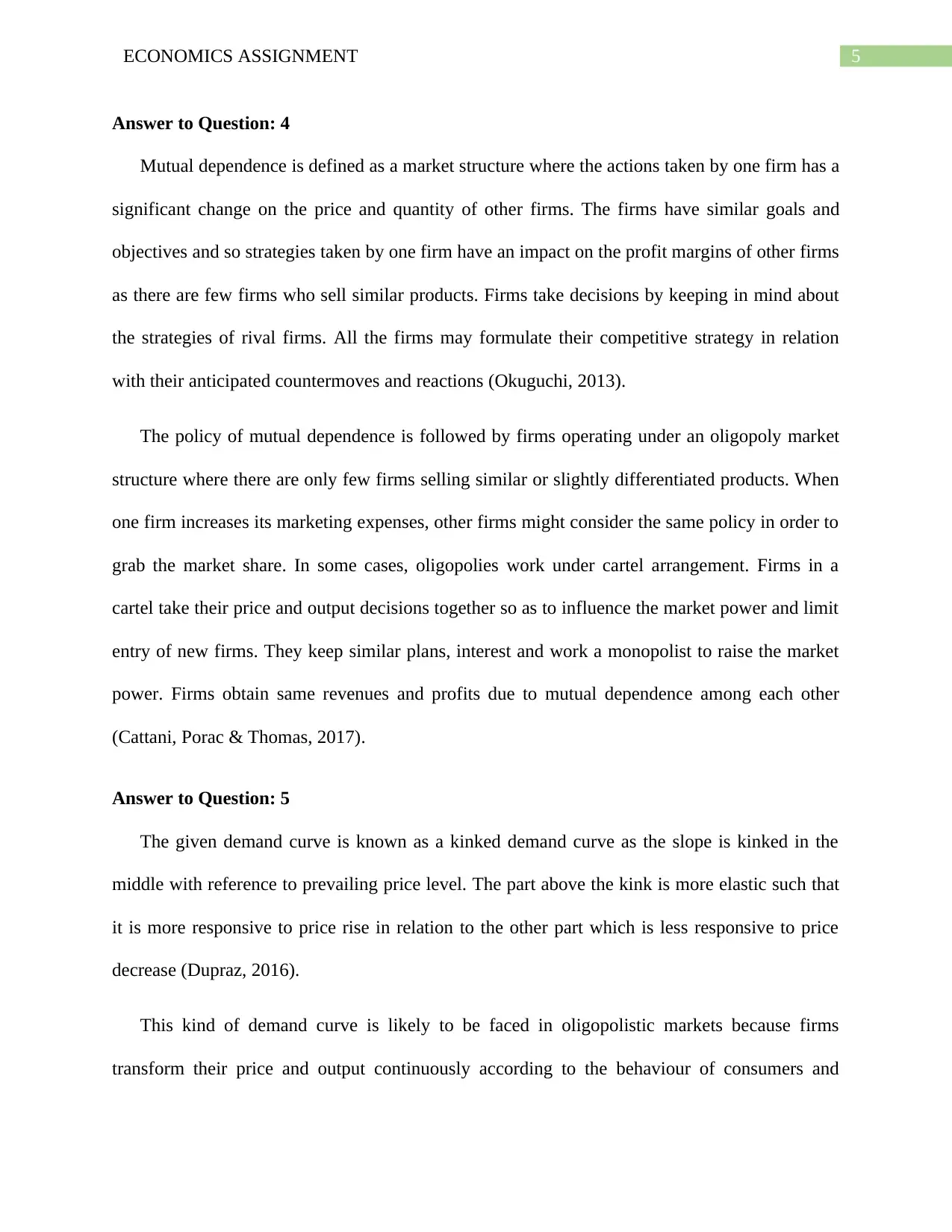
5ECONOMICS ASSIGNMENT
Answer to Question: 4
Mutual dependence is defined as a market structure where the actions taken by one firm has a
significant change on the price and quantity of other firms. The firms have similar goals and
objectives and so strategies taken by one firm have an impact on the profit margins of other firms
as there are few firms who sell similar products. Firms take decisions by keeping in mind about
the strategies of rival firms. All the firms may formulate their competitive strategy in relation
with their anticipated countermoves and reactions (Okuguchi, 2013).
The policy of mutual dependence is followed by firms operating under an oligopoly market
structure where there are only few firms selling similar or slightly differentiated products. When
one firm increases its marketing expenses, other firms might consider the same policy in order to
grab the market share. In some cases, oligopolies work under cartel arrangement. Firms in a
cartel take their price and output decisions together so as to influence the market power and limit
entry of new firms. They keep similar plans, interest and work a monopolist to raise the market
power. Firms obtain same revenues and profits due to mutual dependence among each other
(Cattani, Porac & Thomas, 2017).
Answer to Question: 5
The given demand curve is known as a kinked demand curve as the slope is kinked in the
middle with reference to prevailing price level. The part above the kink is more elastic such that
it is more responsive to price rise in relation to the other part which is less responsive to price
decrease (Dupraz, 2016).
This kind of demand curve is likely to be faced in oligopolistic markets because firms
transform their price and output continuously according to the behaviour of consumers and
Answer to Question: 4
Mutual dependence is defined as a market structure where the actions taken by one firm has a
significant change on the price and quantity of other firms. The firms have similar goals and
objectives and so strategies taken by one firm have an impact on the profit margins of other firms
as there are few firms who sell similar products. Firms take decisions by keeping in mind about
the strategies of rival firms. All the firms may formulate their competitive strategy in relation
with their anticipated countermoves and reactions (Okuguchi, 2013).
The policy of mutual dependence is followed by firms operating under an oligopoly market
structure where there are only few firms selling similar or slightly differentiated products. When
one firm increases its marketing expenses, other firms might consider the same policy in order to
grab the market share. In some cases, oligopolies work under cartel arrangement. Firms in a
cartel take their price and output decisions together so as to influence the market power and limit
entry of new firms. They keep similar plans, interest and work a monopolist to raise the market
power. Firms obtain same revenues and profits due to mutual dependence among each other
(Cattani, Porac & Thomas, 2017).
Answer to Question: 5
The given demand curve is known as a kinked demand curve as the slope is kinked in the
middle with reference to prevailing price level. The part above the kink is more elastic such that
it is more responsive to price rise in relation to the other part which is less responsive to price
decrease (Dupraz, 2016).
This kind of demand curve is likely to be faced in oligopolistic markets because firms
transform their price and output continuously according to the behaviour of consumers and
⊘ This is a preview!⊘
Do you want full access?
Subscribe today to unlock all pages.

Trusted by 1+ million students worldwide
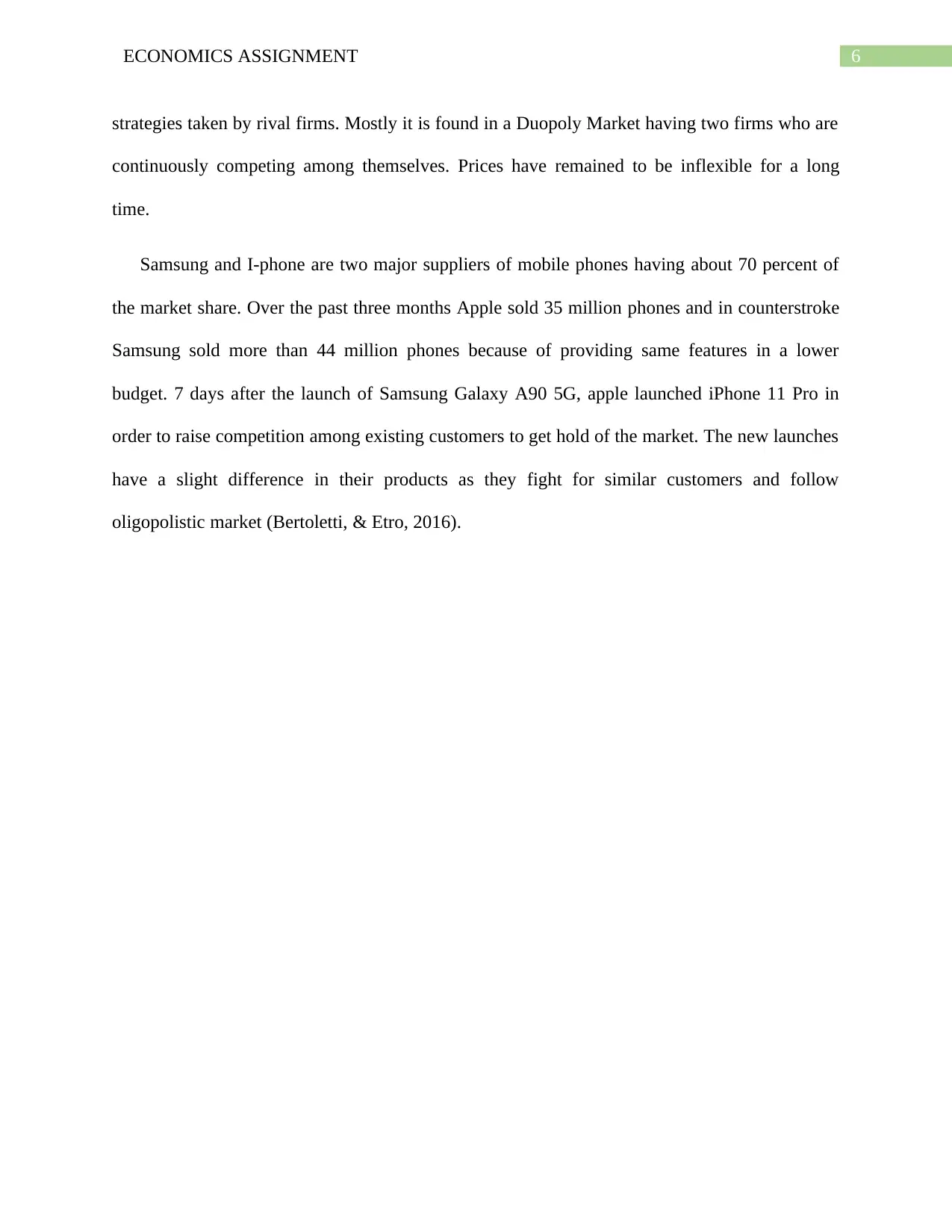
6ECONOMICS ASSIGNMENT
strategies taken by rival firms. Mostly it is found in a Duopoly Market having two firms who are
continuously competing among themselves. Prices have remained to be inflexible for a long
time.
Samsung and I-phone are two major suppliers of mobile phones having about 70 percent of
the market share. Over the past three months Apple sold 35 million phones and in counterstroke
Samsung sold more than 44 million phones because of providing same features in a lower
budget. 7 days after the launch of Samsung Galaxy A90 5G, apple launched iPhone 11 Pro in
order to raise competition among existing customers to get hold of the market. The new launches
have a slight difference in their products as they fight for similar customers and follow
oligopolistic market (Bertoletti, & Etro, 2016).
strategies taken by rival firms. Mostly it is found in a Duopoly Market having two firms who are
continuously competing among themselves. Prices have remained to be inflexible for a long
time.
Samsung and I-phone are two major suppliers of mobile phones having about 70 percent of
the market share. Over the past three months Apple sold 35 million phones and in counterstroke
Samsung sold more than 44 million phones because of providing same features in a lower
budget. 7 days after the launch of Samsung Galaxy A90 5G, apple launched iPhone 11 Pro in
order to raise competition among existing customers to get hold of the market. The new launches
have a slight difference in their products as they fight for similar customers and follow
oligopolistic market (Bertoletti, & Etro, 2016).
Paraphrase This Document
Need a fresh take? Get an instant paraphrase of this document with our AI Paraphraser
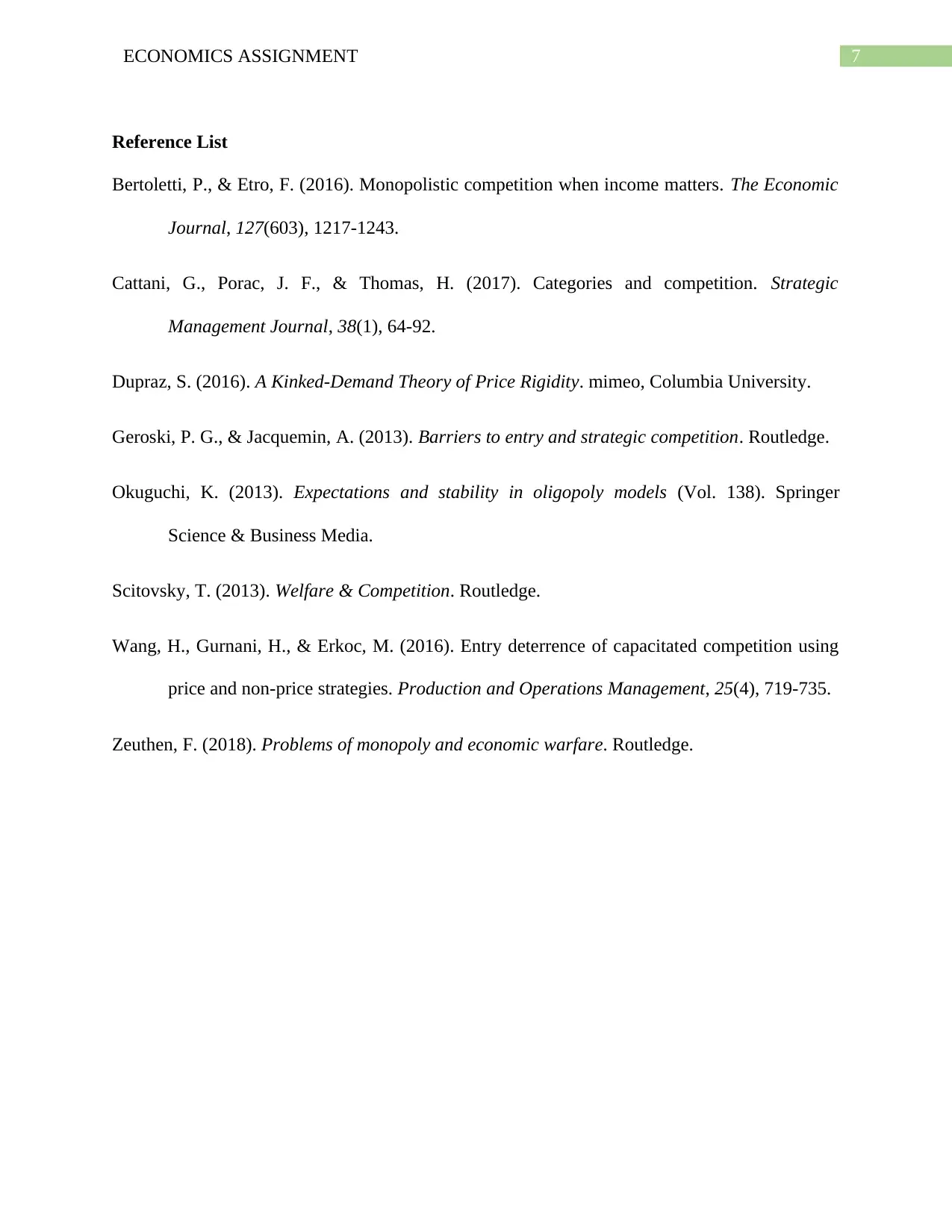
7ECONOMICS ASSIGNMENT
Reference List
Bertoletti, P., & Etro, F. (2016). Monopolistic competition when income matters. The Economic
Journal, 127(603), 1217-1243.
Cattani, G., Porac, J. F., & Thomas, H. (2017). Categories and competition. Strategic
Management Journal, 38(1), 64-92.
Dupraz, S. (2016). A Kinked-Demand Theory of Price Rigidity. mimeo, Columbia University.
Geroski, P. G., & Jacquemin, A. (2013). Barriers to entry and strategic competition. Routledge.
Okuguchi, K. (2013). Expectations and stability in oligopoly models (Vol. 138). Springer
Science & Business Media.
Scitovsky, T. (2013). Welfare & Competition. Routledge.
Wang, H., Gurnani, H., & Erkoc, M. (2016). Entry deterrence of capacitated competition using
price and non‐price strategies. Production and Operations Management, 25(4), 719-735.
Zeuthen, F. (2018). Problems of monopoly and economic warfare. Routledge.
Reference List
Bertoletti, P., & Etro, F. (2016). Monopolistic competition when income matters. The Economic
Journal, 127(603), 1217-1243.
Cattani, G., Porac, J. F., & Thomas, H. (2017). Categories and competition. Strategic
Management Journal, 38(1), 64-92.
Dupraz, S. (2016). A Kinked-Demand Theory of Price Rigidity. mimeo, Columbia University.
Geroski, P. G., & Jacquemin, A. (2013). Barriers to entry and strategic competition. Routledge.
Okuguchi, K. (2013). Expectations and stability in oligopoly models (Vol. 138). Springer
Science & Business Media.
Scitovsky, T. (2013). Welfare & Competition. Routledge.
Wang, H., Gurnani, H., & Erkoc, M. (2016). Entry deterrence of capacitated competition using
price and non‐price strategies. Production and Operations Management, 25(4), 719-735.
Zeuthen, F. (2018). Problems of monopoly and economic warfare. Routledge.
1 out of 8
Related Documents
Your All-in-One AI-Powered Toolkit for Academic Success.
+13062052269
info@desklib.com
Available 24*7 on WhatsApp / Email
![[object Object]](/_next/static/media/star-bottom.7253800d.svg)
Unlock your academic potential
Copyright © 2020–2025 A2Z Services. All Rights Reserved. Developed and managed by ZUCOL.





